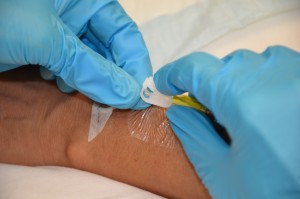
In the past, IV medications given as described above were referred to as IV bolus or IV push medications. It is recommended that these terms NOT be used, as they can be mistakenly interpreted as meaning the drugs are to be pushed quickly, in less than a minute (ISMP, 2003). To administer IV medications safely and effectively, nurses must follow all agency policies and use PDTM guidelines to determine which medications can be given intravenously and any specific instructions about administration (Alberta Health Services, 2009).
Intravenous (IV) is a route for administering concentrated medications (diluted or undiluted) directly into the vein. Depending on the medication and the purpose, meds given IV may be through continuous infusions, mini-bags, or more quickly by what is referred to as direct IV. The IV direct route refers to the administration of a small volume of fluid / medication (max. 20 ml) pushed manually into the patient using a syringe Leur locked to a needleless port. Medications given by direct IV are usually administered intermittently to treat emergent concerns. Medications administered by direct IV route are given very slowly over at least one minute (Perry et al., 2014). The nurse must consult drug monographs and / or Parenteral Drug Therapy Manual (PDTM) for specifics about each medication. Administering a medication intravenously eliminates the process of drug first pass by depositing the medication directly into the blood. This results in the immediate elevation of serum drug levels and high drug concentrations in vital organs, such as the heart, brain and kidneys. Both therapeutic and adverse effects can occur quickly with IV direct administration (Alberta Health Services, 2009).
There are many advantages and disadvantages to administering medications via the intravenous injection method—see Table 7.7.
Intravenous medications are always prepared using the SEVEN rights and THREE checks as per agency policy. Because of the high risk associated with direct intravenous medications, additional guidelines are required. A PDTM or drug monograph provides additional information to help the nurse make decisions about administering IV medications. Some medications can be given either IV direct or piggyback, in which case the nurse must use their knowledge about the patient to determine which of these is preferred. Some medications may only be given in large-volume IV solutions; some medications have to be diluted; some medications have to be administered over specific time frames (i.e., over 1 or 2 minutes). In addition, information regarding indications, contraindications, dosage (age dependent), administration/dilution guidelines, adverse effects, clinical indications (e.g., specialized monitoring required, must be on an IV pump), compatibility and incompatibility in relation to reconstitution and primary IV solution is specified (Alberta Health Services, 2009).
The Institute for Safe Medication Practices (ISMP) (2014) has created a list of high-alert medications that bear the heightened risk of significant harm when they are used in error. Special safeguards for these medications can be found in the PDTM. It is vital to understand which medications are considered high risk prior to administration. A link to the list of high-risk medications can be found under Suggested Online Resources at the end of this chapter. Review the steps shown in Table 7.8 to prepare a medication by direct IV route. The PDTM must be consulted every time an IV medication is given, as memory-based errors are common (World Health Organization, 2012).
Are you qualified to give this medication? What supervision is required? What resources must you consult?
Can this medication be given by the IV route? Is the route of administration (needle insertion site) free from redness, swelling, and discomfort?
Before giving an intravenous medication, always assess the IV insertion site for patency and for signs of infiltration or phlebitis. Start a new IV site if current site is red, swollen, or painful when flushing. Intravenous medications by direct IV route can be given three ways:
Checklist 60 reviews the steps to administer a medication IV direct into a locked / capped IV. Review the preparation questions for intravenous medication in Table 7.8 prior to administering medication.
Review the agency policy if a medication is a stat, given for the first time, a loading dose, or a one-time dose.
Some agencies require that high-alert medications be double-checked by a second health care provider. Always follow agency policies. For a list of high-alert medications, see Suggested Online Resources.

PVAD short:
Midline, CVC (PICC / percutaneous non-hemodialysis line):
Aspirating on a PVAD short often does not reveal blood flashback despite the site being patent. Assess for patency of PVAD short during the flush by assessing for resistance, pain, and leaking. If you suspect the line is not patent, STOP. DO NOT forward flush. Remove the PVAD short and reestablish a new one.
Turbulent flush is a stop start vigorous motion intended to clean the inside lumen of the VAD.
Aspirating on a PICC, midline, and percutaneous non-hemodialysis CVC should reveal blood flashback. If you suspect the line is not patent, or partially occluded, follow agency guidelines (this usually involves trouble shooting and / or consulting the IV team / PICC nurse for declotting).
Using a needleless system prevents needle-stick injuries.
Use 10 ml syringe (minimum) to reduce risk of catheter fracture.
Clean access port using alcohol and friction for 15 seconds.
Luer lock 10 ml saline filled syringe to the needleless cap. Flush with volume directed by agency ‘s flushing protocol at the SAME rate as the medication delivery, according to guidelines found in the PDTM. (See Rationale for Flushing with NS after Administering an IV Medication)
Ensure the final flush is done in a way that ensures positive pressure is achieved. This will depend on what kind of needleless cap and what kind of saline filled syringe is available to you. See Positive Pressure.
Cleaning access ports before each syringe is attached and after each syringe is detached reduces risk of infection.
Check agency flushing protocol for flushing volume.
Flushing the IV line at the same rate as medication delivery ensures that any medication remaining within the IV line is delivered at the correct rate, and avoids the patient receiving an accidental bolus of the medication.
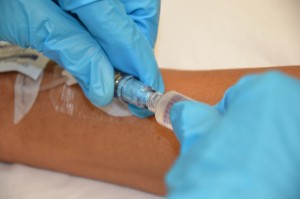
Flushing the extension tubing clears the medication from the device.
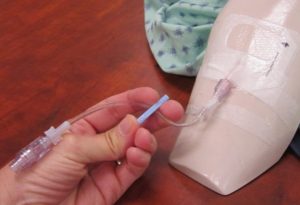
Note: If a patient has a central venous catheter, follow agency protocols for accessing and flushing and locking.
Watch the video: Administering Medications: Direct IV – Into a Locked IV (PVAD short) by Renée Anderson & Wendy McKenzie Thompson Rivers University
Here are some examples of clearing IV medication from the extension tubing on a PVAD short saline lock.
Checklist 61 lists the steps to administering an IV medication through an existing IV line with compatible IV solution. Review the preparation questions for intravenous medication in Table 7.8 prior to the medication administration.
Review the agency policy if a medication is a stat, first-time, loading dose, or a one-time dose.
Some agencies require high-alert medications to be double-checked by a second health care provider. Always follow agency policies.
After preparing the medication, always label the medication syringe with two patient identifiers, date, time, medication, dose (e.g., morphine 2 mg), and your initials. Never leave the syringe unattended.
If medications given simultaneously are incompatible, the mixing of these can create precipitates in the IV tubing which can initiate emboli formation in the blood.
Stopping infusions that containing medications interrupts delivery of that medication.
Cleaning access ports before each syringe is attached and after each syringe is detached reduces risk of infection. Alcohol and friction sanitizes. Allowing alcohol to dry renders the antiseptic properties effective.
Luer lock a 10 ml saline filled syringe to the access port closest to the patient.
Aspirate and assess for blood flashback in the line. Forward flush 10 ml normal saline syringe using turbulent technique. THIS IS THE FLUSH PRIOR.
Checking patency of midline, CVC (PICC / non-hemodialysis line): aspirate for blood return. When blood flashback present in tubing, forward flush using turbulent technique. If there is no blood return, trouble shoot according to agency protocol and / or contact the IV team / PICC nurse for further assessment.
Using a needleless system prevents needle-stick injuries.
New recommendations include flushing before AND after medication administration.
Clean IV access port for 15 seconds with alcohol and friction. Allow to dry.
Clean port using alcohol and friction.
Luer lock a 10 ml saline filled syringe to the access port.
Flush with volume directed by agency flushing protocol at the SAME rate as the medication delivery, according to guidelines found in the PDTM. (See Rationale for Flushing with NS after Administering an IV Medication.) THIS IS THE FLUSH AFTER.
Resume the infusion.
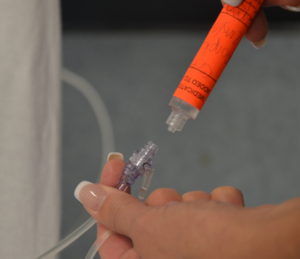
Alcohol and friction sanitizes. Allowing alcohol to dry renders the antiseptic properties effective. Cleaning access ports before each syringe is attached and after each syringe is detached reduces risk of infection.
The final flush does NOT have to ensure positive pressure is achieved because the infusion will be resumed.
Watch the video: Administering Medications: Direct IV – Into an IV with an Infusion by Renée Anderson & Wendy McKenzie Thompson Rivers University
Checklist 62 reviews the steps to administer an IV medication through an existing IV line with incompatible IV solution. Review the preparation questions for intravenous medication in Table 7.8 prior to the medication administration.
Review the agency policy if a medication is a stat, first-time, loading dose, or a one-time dose.
Some agencies require that high-alert medications be double-checked by a second health care provider. Always follow agency policies.
After preparing the medication, always label the medication syringe with two patient identifiers, date, time, medication and dose (e.g., morphine 2 mg), dose, and your initials. Never leave the syringe unattended.
Cleaning access ports before each syringe is attached and after each syringe is detached reduces risk of infection. Alcohol and friction sanitizes. Allowing alcohol to dry renders the antiseptic properties effective.
Stopping the infusion for an IV run by gravity involves clamping a slide clamp distal to the access port or rolling the roller clamp to the closed position OR fold the tubing on itself and pinch
Luer lock a 10 ml saline filled syringe to the access port closest to the patient. Aspirate and assess for blood flashback in the line. Forward flush 10 ml syringe using turbulent technique.
THIS FLUSH WILL CLEAR THE LINE OF THE INCOMPATIBLE MEDICATION.
PVAD short sites that are not patent may be edematous (suggests infiltration) or not infusing (observe for drops in the drip chamber); or the IV pump indicates occlusion.
Checking patency of midline, CVC (PICC / non-hemodialysis line): aspirate for blood return. When blood flashback is present in tubing, forward flush using turbulent technique. If there is no blood return, trouble shoot according to agency protocol and / or contact the IV team / PICC nurse for further assessment.
Using a needleless system prevents needle-stick injuries.
Clean IV access port for 15 seconds with alcohol and friction.
Inject medication at the recommended rate according to PDTM. Use a timer / watch / clock to monitor time. Administer the medication slow and steady. Attempt to have half of the syringe emptied in half of the recommended infusion time.
Remove empty syringe. Clean port for 15 seconds using alcohol and friction.
Attach a 10 ml normal saline syringe. Flush with volume directed by agency flushing protocol at the SAME rate as the medication delivery, according to guidelines found in the PDTM. (See Rationale for Flushing with NS after Administering an IV Medication.) THIS FLUSH REMOVES MEDICATION FROM THE TUBING.
This ensures safe medication administration at the correct rate. Rapid injection of IV medications can have serious consequences for the patient
Always assess IV sites before and after administration of IV medications.
This step delivers the medication that remains in the IV tubing at the same rate, and prevents patient from accidentally receiving a bolus of the medication. It also clears the IV line to prevent any mixing of incompatible medication with the IV solution.
Assess the IV site.
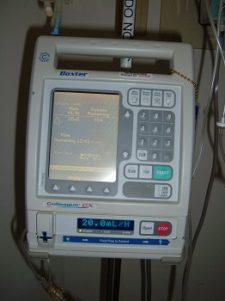
Figure 7.20 Cleaning access port by author is licensed under a Creative Commons Attribution 4.0 International License.
Figure 7.30 Leur lock syringe to needleless cap by author is licensed under a Creative Commons Attribution 4.0 International License.
Figure 7.31 Apply slide clamp by author is licensed under a Creative Commons Attribution 4.0 International License.
Clinical Procedures for Safer Patient Care Copyright © 2018 by Thompson Rivers University is licensed under a Creative Commons Attribution 4.0 International License, except where otherwise noted.